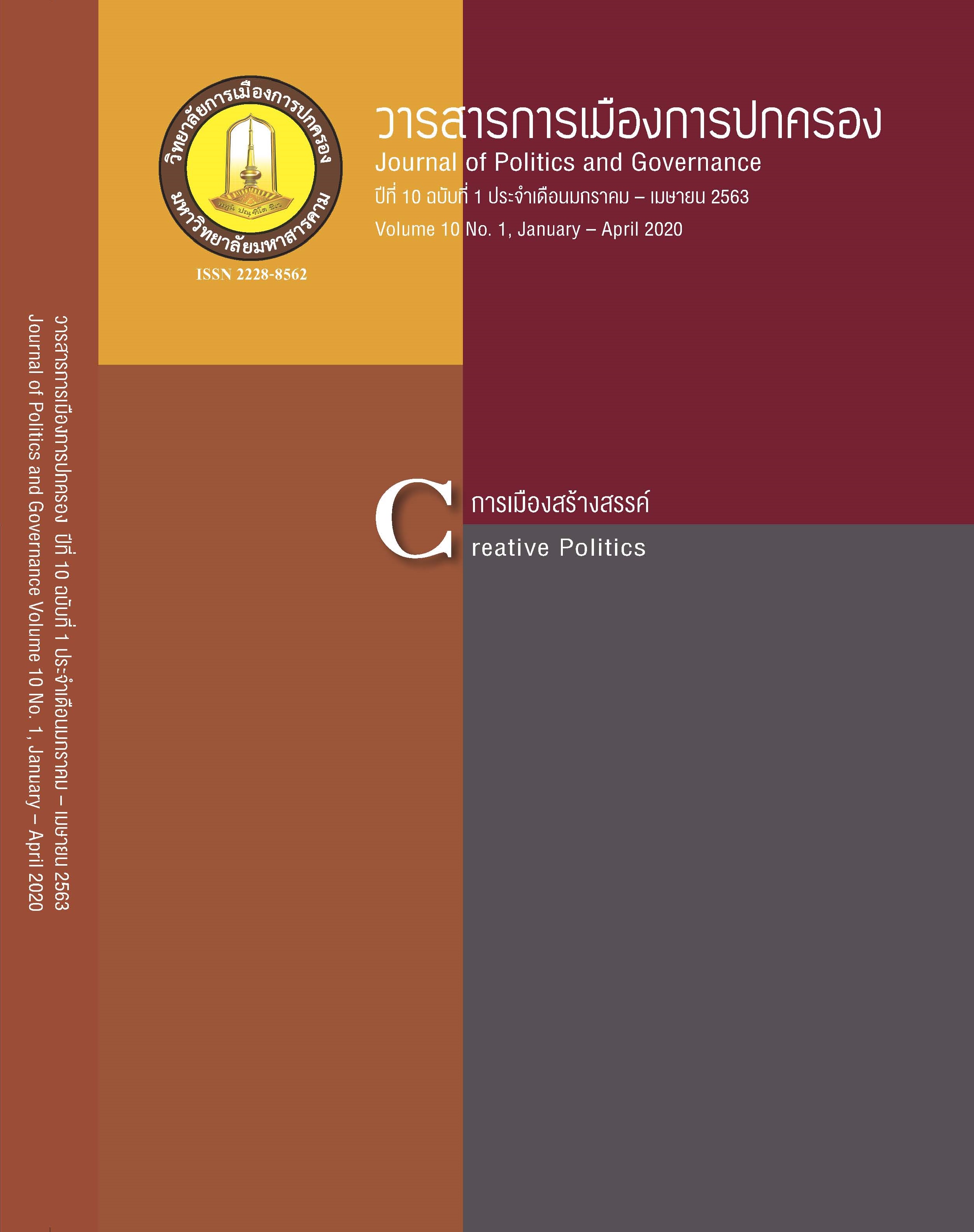การจัดการความขัดแย้งเชิงสมานฉันท์ภายใต้แนวคิดยุติธรรมชุมชน : กรณีศึกษาเครือข่ายยุติธรรมชุมชน อำเภอพนมสารคาม จังหวัดฉะเชิงเทรา
Main Article Content
บทคัดย่อ
การวิจัยนี้มีวัตถุประสงค์เพื่อทราบถึงกระบวนการและผลการดำเนินงาน ปัจจัยที่มีผลต่อความสำเร็จ ปัญหาและอุปสรรค ตลอดจนเสนอแนวทางในการพัฒนาการจัดการความขัดแย้งเชิงสมานฉันท์ของเครือข่ายยุติธรรมชุมชน โดยอาศัยกรอบแนวคิดการจัดการความขัดแย้งเชิงสมานฉันท์ในชุมชนเป็นแนวทางในการศึกษาวิเคราะห์ โดยใช้วิธีวิจัยเชิงคุณภาพทำการเก็บรวบรวมข้อมูลจากปรากฏการณ์ที่เกิดขึ้นจริง คัดเลือกกรณีศึกษา การใช้การสัมภาษณ์เชิงลึกกับคู่ขัดแย้ง ผู้ไกล่เกลี่ย และผู้ให้ข้อมูลสำคัญ การสังเกตการณ์แบบมีส่วนร่วมในกระบวนการจัดการความขัดแย้ง รวมทั้งการสนทนากลุ่ม และนำข้อมูลที่ได้มาสรุปตามประเด็นการศึกษาที่ได้กำหนดไว้ นำไปสู่ข้อสรุปที่เป็นแนวทางการพัฒนาการจัดการความขัดแย้งเชิงสมานฉันท์ของเครือข่ายยุติธรรมชุมชน ผลการวิจัย พบว่า กระบวนการในการจัดการความขัดแย้งเชิงสมานฉันท์ของเครือข่ายยุติธรรมชุมชนประกอบด้วย การรับข้อร้องเรียนหรือการเสนอปัญหา การหาข้อมูลและข้อเท็จจริงของความขัดแย้ง การหาความต้องการที่แท้จริงของคู่ขัดแย้ง การให้แต่ละฝ่ายได้เสนอมุมมอง ความคิดเห็น และความต้องการของตนต่อคู่ขัดแย้ง การจัดการความขัดแย้งโดยการเจรจาต่อรองและการไกล่เกลี่ย การยินยอมและทำบันทึกข้อตกลง และการติดตามผลการจัดการความขัดแย้ง โดยมีปัจจัยที่มีผลต่อความสำเร็จของการจัดการความขัดแย้งเชิงสมานฉันท์ประกอบด้วย 1) ด้านเครือข่ายศูนย์ยุติธรรมชุมชน ที่มีที่ตั้งในชุมชน สะดวกแก่การบริการ การดำเนินงานไม่มีการเรียกเก็บค่าใช้จ่าย การดำเนินงานมีลักษณะเป็นเครือข่าย และได้รับการสนับสนุนจากกระทรวงยุติธรรม 2) ด้านบุคลากร มีบุคลากรที่ได้รับความน่าเชื่อถือในความเป็นกลาง มีความรู้ความเข้าใจในกระบวนการจัดการความขัดแย้ง ตลอดจนกฎหมายที่เกี่ยวข้อง มีความเต็มใจในการปฏิบัติหน้าที่ เข้าใจในสภาพแวดล้อมของชุมชน มีประสบการณ์ในการดำเนินงานด้านการจัดการความขัดแย้ง รวมทั้งมีการทำงานเป็นทีมในรูปแบบของคณะทำงาน 3) ด้านคู่ขัดแย้ง เข้าร่วมกระบวนการด้วยความยินยอม ยอมรับการดำเนินการและให้ความเชื่อถือต่อการดำเนินงานของเครือข่ายยุติธรรมชุมชน และให้ความสำคัญกับการรักษาความสัมพันธ์อันดีระหว่างกัน 4) ด้านกระบวนการจัดการความขัดแย้ง เครือข่ายยุติธรรมชุมชนมีหลากหลายวิธีการสามารถปรับใช้ให้เข้ากับสถานการณ์ การดำเนินงานมีความโปร่งใสและมีการสื่อสารทำความเข้าใจกับผู้เกี่ยวข้อง ก่อให้เกิดความเชื่อมั่นในกระบวนการนำไปสู่ความร่วมมือในการปฏิบัติตามกระบวนการของคู่ขัดแย้ง ปัญหาและอุปสรรคในการจัดการความขัดแย้งเชิงสมานฉันท์ พบว่า เครือข่ายยุติธรรมชุมชนดำเนินการโดยไม่ได้รับงบประมาณจากภาครัฐ ส่งผลต่อการขาดแคลนงบประมาณ เครื่องมือ วัสดุอุปกรณ์ และการพัฒนา การดำเนินงานไม่มีกฎหมายรองรับ ทำให้บางครั้งขาดอำนาจในการบังคับให้เป็นไปตามข้อตกลง การดำเนินงานมีลักษณะการอาศัยบารมีของผู้ทำหน้าที่ไกล่เกลี่ย อาจมีการนำความสัมพันธ์ส่วนตัวมาเป็นปัจจัยในการจัดการความขัดแย้ง มีบุคคลที่สามหรือหน่วยงานภายนอกเข้ามาแทรกแซงทำให้การดำเนินงานไม่สามารถทำให้ความขัดแย้งยุติลงได้ บุคลากรขาดแรงจูงใจในรูปแบบของค่าตอบแทน และขาดความมั่นคงในการทำงาน รวมทั้งบางกรณีคู่ขัดแย้งมาจากภายนอกชุมชน ไม่มีความผูกพันกับชุมชน ทำให้ไม่เกิดความรู้สึกที่จะสมานฉันท์กับเพื่อชุมชน แต่กลับมุ่งแพ้ชนะไม่ยอมกัน
แนวทางการพัฒนาการจัดการความขัดแย้งเชิงสมานฉันท์ภายใต้แนวคิดยุติธรรมชุมชน ผู้วิจัยได้เสนอแนวทางดังนี้ 1) การออกกฎหมายสนับสนุนและรองรับการดำเนินงานของเครือข่ายยุติธรรมชุมชน 2) การสนับสนุนด้านงบประมาณจากภาครัฐหรือจากองค์กรปกครองส่วนท้องถิ่น 3) การสนับสนุนให้เจ้าหน้าที่ทั้งจากส่วนกลาง ภูมิภาค และท้องถิ่นเป็นส่วนหนึ่งของคณะทำงาน 4) การพัฒนาการประสานงานทั้งในระดับนโยบาย แผนงาน และปฏิบัติงาน 5) การพัฒนาและสร้างระบบการบริหารทรัพยากรมนุษย์เพื่อพัฒนาบุคลากรที่เป็นคณะทำงาน 6) พัฒนาเครื่องมือในการจัดเก็บข้อมูลหรือการดำเนินงานของเครือข่าย และ 7) การพัฒนาการทำงานเชิงรุกในการเข้าถึงและประสานระหว่างคนในชุมชน เป็นการเสริมสร้างความเข้าใจซึ่งกันและกันและป้องกันการเกิดความขัดแย้งในชุมชน
Article Details
เอกสารอ้างอิง
จุฑารัตน์ เอื้ออำนวย และคณะ. (2548). กระบวนการยุติธรรมเชิงสมานฉันท์ : การคืน “อำนาจ” แก่เหยื่ออาชญากรรมและชุมชน. สำนักงานกองทุนสนับสนุนการวิจัย. กรุงเทพฯ.
จุฑารัตน์ เอื้ออำนวย. (2556). ระบบยุติธรรมและยุติธรรมทางเลือก : แนวการวิเคราะห์เชิงสังคมศาสตร์. จุฬาลงกรณ์มหาวิทยาลัย. กรุงเทพฯ.
สำนักงานศาลยุติธรรม. (2557). รายงานสถิติคดีศาลยุติธรรมทั่วราชอาณาจักร ประจำปี 2557. สำนักงานศาลยุติธรรม. กรุงเทพฯ
_________. 2558). รายงานสถิติคดีศาลยุติธรรมทั่วราชอาณาจักร ประจำปี 2558. สำนักงานศาลยุติธรรม. กรุงเทพฯ
สำนักงานศาลยุติธรรม. (2559). รายงานสถิติคดีศาลยุติธรรมทั่วราชอาณาจักร ประจำปี 2559. สำนักงานศาลยุติธรรม. กรุงเทพฯ
________. (2560). รายงานสถิติคดีศาลยุติธรรมทั่วราชอาณาจักร ประจำปี 2560. สำนักงานศาลยุติธรรม. กรุงเทพฯ
อภิรดี พลีน้อย และคณะ. (2555). การพัฒนาการจัดการความขัดแย้งในชุมชน โดยใช้กระบวนการ ไกล่เกลี่ยข้อพิพาทชุมชนโดยอาสาสมัครไกล่เกลี่ยข้อพิพาทชุมชน. วารสารวไลยอลงกรณ์ปริทัศน์, 2 (กรกฎาคม-ธันวาคม), 39-48.
John Braithwaite. (1998). Restorative Justice in M. Tonry (ed). The Handbook of Crime and Punishment, 323-344. New York. Oxford University Press.
Karp, D. and Clear T. (2000). Community Justice: A Conceptual Framework. In Criminal Justice 2000. Chares M. Friel, ed. United States Department of Justice, Officer of Justice Programs, National Institute of Justice, 2(2), pp. 323-368. Washington, DC.


